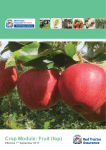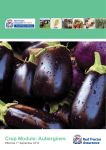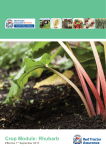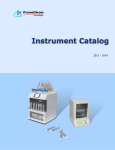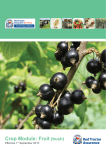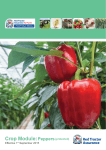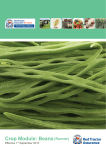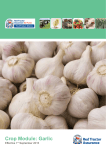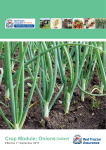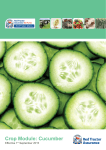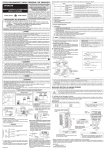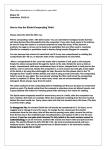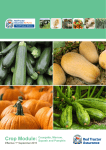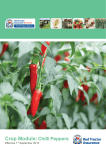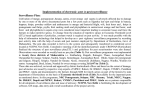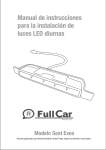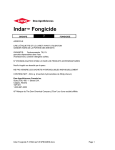Download Crop Module: Fruit (stone)
Transcript
Crop Module: Fruit (stone) Effective 1st September 2015 Welcome T his crop specific module for fruit (stone) has been written to complement and avoid duplicating the generic principles of the Red Tractor Farm Assurance Fresh Produce Scheme standards. It is advisable to read the Red Tractor Farm Assurance Fresh Produce standards before reading this crop specific module. This module is designed to stimulate thought in the mind of the reader. It contains crop specific guidance and standards, where applicable, in addition to the requirements stated in the generic Fresh Produce standards. Within this module the important requirements outlined in the crop specific standards section will be verified during the Red Tractor Farm Assurance assessment and compliance will form a part of the certification/approval decision. Disclaimer and trade mark acknowledgement Although every effort has been made to ensure accuracy, Assured Food Standards does not accept any responsibility for errors and omissions. Trade names are only used in this module where use of that specific product is essential. All such products are annotated® and all trademark rights are hereby acknowledged. General Introduction Following a systematic approach will help growers identify and manage the risks involved in crop production. This module is based on a typical crop production process and food safety, health & safety, environmental and quality hazards are identified. Appropriate controls may then be established to minimise risk. Food safety and health & safety issues always take precedent over quality and environmental controls. The layout of this module follows the same structure as that used in the Red Tractor Farm Assurance Fresh Produce Standards. The content of the module is reviewed prior to the issue of updated editions. The review process considers both new developments and all relevant technology which has emerged since the last review was completed and which have been found to be both workable by the grower and beneficial to the environment. The aim is to transfer such information and technologies to growers. Acknowledgements Red Tractor Farm Assurance Fresh Produce gratefully acknowledges the contribution of all consultees in the preparation of this protocol, particularly Don Vaughan (Horticultural Consultant). Notes: Pesticide Information The Red Tractor Fresh Produce team has been working with Fera to provide tailored access to the LIAISON database for all Red Tractor Fresh Produce members. This system allows individual growers access to all information for plant protection products approved for use under the Red Tractor Fresh Produce Scheme. LIAISON can be accessed under the Produce tab via the “Checkers and Services” page where you will also find a user manual. Searches will be filtered specifically for the crops for which you are registered. Once you have logged onto the site and clicked on the LIAISON hyperlink you will be directed to the LIAISON home screen. You will need a username and password and these will be sent once you have registered: http://assurance.redtractor.org.uk/rtassurance/ services/Registration/members.eb . Front cover image credit: Don Vaughan. 1 Red Tractor Assurance for Farms – Crop-specific Module: Fruit (stone) © Assured Food Standards 2015 Content Contents ADDITIONAL REQUIREMENTS AGAINST CURRENT STANDARDS 02 CROP SPECIFIC STANDARDS02 SITE AND SOIL MANAGEMENT 03 ENVIRONMENTAL PROTECTION AND CONTAMINATION CONTROL03 PEST, DISEASE AND WEED CONTROL 04 NUTRITION 12 HARVEST AND STORAGE 12 RESIDUES AND CONTAMINANTS 13 APPENDIX 1: PESTICIDE RESIDUES IN STONE FRUIT CROPS15 APPENDIX 2: CONDITIONS CONTROLLING REDUCED SPRAY APPLICATION16 APPENDIX 3: ORCHARD ROT RECORD SHEETS17 ADDITIONAL REQUIREMENTS AGAINST CURRENT STANDARDS None for this crop module CROP SPECIFIC STANDARDS STANDARDS HOW YOU WILL BE MEASURED RECORDS (to be kept for 2 years) n Soil CQ.28.a Soil type and crop load, in conjunction with soil and leaf analysis must be considered before the application of fertiliser Red Tractor Assurance for Farms – Crop-specific Module: Fruit (stone) and/ or leaf analysis records © Assured Food Standards 2015 2 GUIDANCE SITE AND SOIL MANAGEMENT When selecting a new orchard site, aspect, frost susceptibility, soil type, pH and soil drainage should be considered. All plantations should be protected by windbreaks/ hedges to ensure that an adequate microclimate can be maintained whilst minimising spray drift. It is essential that as some of the more recently introduced cherry rootstocks are susceptible to Phytophthora, sufficient effort is put in to ensure that good soil structure and adequate drainage is achieved prior to planting. ENVIRONMENTAL PROTECTION & CONTAMINATION CONTROL PRODUCT SELECTION When choosing a product select the most environmentally benign that provides effective control. Products with a label recommendation for use in cherry and plum orchards are listed in the Appendix by pest or disease. The harvest interval (HI) (in days) has been included. Products listed as safe (S) or moderately safe (MS) to typhs anthocorids and ladybirds should be used as a first preference in both plum and cherry orchards. RECORDS OF PESTICIDE APPLICATIONS Although suggested layouts have been provided in the Appendix for recording orchard details and pesticide treatments, computerised record keeping systems are quite acceptable provided that they capture equivalent information. Pesticide application records should be completed as the spray programme is applied to the orchard. A copy of each record should be forwarded to the marketing organisation, which is to handle the fruit as convenient (no later than the first harvest date of the fruit). The original should be retained by the grower for reference and to fulfil the legal requirements. Where a common basic spray programme is used across a whole farm it is acceptable to record the base programme which covers all orchards once only and to record special treatments for individual orchards on an exceptional basis. The pesticide the following: application record should include Product: State full trade & chemical name of pesticide as printed on the label. Rate: At the top of the ‘Rate’ column enter the units to be used (quantity of pesticide per unit area), and in the rows the volume of spray applied per unit area. Volume: At the top of the ‘Volume’ column enter the units to be used (volume of spray per unit area), and in the rows the volume of spray applied per unit area. Operator Name: State the operator’s name to enable monitoring of exposure to pesticides. Target Pest: State target pest, disease or weed, e.g. plum fruit moth. Justification: State pest or disease level or risk as justification for treatment. Weather: The wind speed should be measured at the top of the windbreak and divided by two to give an estimate of the wind speed at crop level. Time: State start and finish times on spray sheet. A suggested pesticide application record form layout is given in Appendix 6. The wind force should be recorded according to the Beaufort Scale, i.e.: 0.Calm. Smoke rises vertically. 1.Direction of wind shown by smoke drift but not by wind vanes. 2. Wind felt on face. Leaves rustle. Ordinary vane moved by wind. 3.Leaves and twigs in constant motion. Wind extends light flags. 4. Raises dust and loose paper. Small branches are moved. 5.Small trees in leaf begin to sway. Crested wavelets form on inland waters. Spraying should not take place if the wind force is greater than force four. Spraying at force zero is not recommended either. Under DEFRA’s Code of Practice foliar sprays should only be applied at wind speeds up to force 2 and 3 and herbicides at force 2. Any other relevant weather conditions should also be entered. Date: State the date of application. Variety(s): State the varieties covered. 3 Red Tractor Assurance for Farms – Crop-specific Module: Fruit (stone) © Assured Food Standards 2015 First permitted harvest date To calculate the first permissible harvest date, refer to the product label and add the appropriate number of days to the date on which it was applied. The first permissible harvest date should be entered and brought forward as a ‘rolling date’ in the spray records. Care should be taken when applying sprays in orchards with early season varieties in order to comply with the minimum harvest interval. Reduced spray volumes The following text has been agreed with DEFRA and with the Health & Safety Executive and is issued by the British Crop Protection Council. “The agrochemical product label is written by the manufacturer and approved by DEFRA to tell the user the correct way to apply the product. Certain parts of the label, the Statutory Conditions of Use, normally indicated in a box on the front panel of the label, must always be followed. The spray volume is one recommendation, which may in some cases be altered to suit the needs of the equipment or of the user. The conditions under which reduced volumes may be used are given in the Code of Practice (1), Sections 144 to 147. The chart (2) is intended to help you to interpret the advice given in the Code and to explain when reduced volume may be considered. The term “reduced volume” is used here to mean any spray volume lower than the minimum recommended on the label. The phrase “for that dose” used in the Code refers to the label recommended dose. CAUTION: Before making any spray application at reduced volume you should read the Code of Practice and follow all the conditions in paragraph 89 which include: Make a written COSHH assessment. Ensure that operator protection is adequate. Use FINE, MEDIUM or COARSE spray quality for vehicle-mounted sprayers, and MEDIUM or COARSE for pedestrian sprayers. Do not exceed the maximum recommended dose. PEST, DISEASE AND WEED CONTROL PEST CONTROL USING PREDATORY INSECTS Encouraging beneficial insects in the orchard One of the most important factors in building up and maintaining beneficial insect numbers is the correct choice of pesticide. Information is given in the appendices to assist the grower to use a predator friendly spray programme. When replanting an orchard or planting up a non-cropping area, give consideration to the types of trees and shrubs chosen. Predators are an essential component for pest control to reduce the reliance on pesticides and should be encouraged at every opportunity. Providing alternative hosts and food sources, which will attract predators at different times in the season to stone fruit orchards, is a valuable way of encouraging predators within the farm. The inclusion of goat willow and hazel alongside the normal alder species will provide food and havens for anthocorid beetles, lacewings and ladybirds. Avoiding the use of herbicides in these areas will allow coarse grass species to flourish, which will provided habits for predators such as ladybirds to hibernate in. In the short term annual flowering plants, such as Phacelia spp, mustard and wild carrots can be sown around headlands or in fallow areas to encourage a wide range of pollinating insects such as, typhlodromid mites, hoverflies, anthocorids and ladybirds. Crop yields in stone fruit improve with adequate pollination, so by encouraging pollinating insects, crop potential can be improved. If the stone fruit flowering period coincides with cold weather conditions, honey bees may not be flying so the presence of natural pollinating insects may be crucial to obtain a viable crop. Increasing biodiversity on the farm is an important factor in building up reliable numbers of predators against a wide range of the pests that will attack fruit crops. Natural predators The key natural predators, i.e. typhlodromid mites and anthocorids on plums and ladybirds on cherries, should be conserved and encouraged. Accept responsibility for efficacy.” (1) Pesticides: Code of Practice for the Safe Use of Pesticides on Farms and Holdings (HMSO ISBN 0 11 242892 4). (2) The chart is reproduced in the Appendix and shows the Code of Practice conditions that apply when using products without a statutory minimum spray volume. Red Tractor Assurance for Farms – Crop-specific Module: Fruit (stone) © Assured Food Standards 2015 4 Typhlodromus pyri Commonly referred to as ‘typhs’, the nymph and adult forms of this mite are very similar in appearance being pear shaped, with pale, almost translucent smooth bodies, and are about 0.3mm long. Adults have 8 legs and are very active on the underside of the leaf and are often found near the main vein. They prefer leaves with numerous leaf hairs and are thus a more important predator on apples than on stone fruit but never the less, they can occur on stone fruit and should therefore be encouraged. Adult females over winter in the orchard hiding in the bark of trees and elsewhere. Many die during the winter. In the spring, surviving adults lay eggs on the underside of leaves. Up to four generations may occur in a season. The adults and nymphs eat large numbers of red spider mites and will even eat rust mite if the red spider mite numbers are low. As they are present all year round in orchards there is no safe time to use insecticides that are not selective to them. As red spider mites are likely to be more prevalent under covered cherries it is essential that typhs are encouraged and that pesticide selections are made with the safety of predators in mind. Typhs should be introduced into orchards where they are not endemic. The most effective way of doing this is to use summer prunings from apple orchards that have known populations of typhs. Research has shown that typhs prefer to move along the tree rows in the orchard so the prunings should be placed in each row, up wind, to help dispersal. Pesticides (1) known to be harmful to typhs Pyrethoids Notes: (1) Not all formulations of each product may be currently approved for use on stone fruit. Check before use. Label recommendations are revised regularly, read a current label before use. 5 Red Tractor Assurance for Farms – Crop-specific Module: Fruit (stone) © Assured Food Standards 2015 Anthocoris nemorum (Common flower bug) ADULT NYMPH Commonly referred to as ‘anthocorids’, the adult and nymph form of this predatory bug are about 4mm long. They are dark brown/black and shiny with geometric pale markings, particularly on the adults. The nymphs may have a red colouration, with 6 legs, long antennae and a long pointed mouthpiece. The adults over winter in a wide range of sites both in and away from orchards. They come out of hibernation from March onwards migrating to willow catkins and lay eggs between March and June which hatch after about 10 days. There are usually two generations. Both adults and nymphs enjoy a varied diet attacking aphid, spider mites, and caterpillars. In order to conserve endemic populations, avoid using products toxic to anthocorids from 2 weeks after petal fall to harvest. Adult Various All organophosphate insecticides Pyrethoids Note: (1) Not all formulations of each product may be currently approved for use on stone fruit. Check before use. Label recommendations are revised regularly, read a current label before use. Red Tractor Assurance for Farms – Crop-specific Module: Fruit (stone) © Assured Food Standards 2015 6 Coccinellidae (ladybirds) Two of the most common species of ladybirds found in fruit plantations are the two spot (Adalia bipunctata) and the ten spot ladybird (Adalia decempunctata). Adults tend to be gregarious when hibernating but on emergence in the spring, mate and then tend to become more solitary. Eggs are laid in batches, upright on leaves. These eggs are creamy white and 1mm in length. The female can lay up to 300 eggs during her lifetime. Development from egg to adult takes several weeks but adults are long lived, with egg laying taking place over the season so all stages are common throughout the summer period. Larvae feed voraciously on aphids and can consume several hundred during their development. If aphid are in short supply, ladybird will eat spider mite, so as they are a common predator, they have a useful impact on both aphid and spider numbers in orchards. As with other predators, the ill-advised use of some of the more toxic sprays has a devastating effect on all stages of development of ladybirds, so a careful sensible approach, when considering spray applications, is necessary. Also the provision of a sympathetic environment for hibernating, e.g. mixed hedgerows and grasses ensure that early migration and colonisation of the orchard can occur the following season. Plum and cherry pest thresholds There are no established thresholds for pests in plum and cherry. Use the following levels as a guide. As experience is gained, they will be confirmed or updated. Plum pest thresholds Dormant period Threshold Plum rust mite Fruit tree red spider mite winter eggs 10 mites per bud 30% branch nodes with >5 eggs Bud-burst to white bud Plum rust mite 5 mites per outer rosette leaf White bud to petal fall Mealy plum aphid presence Leaf- curling plum aphid presence Winter moth caterpillars 5% trusses infested Fruit tree red spider mite 2 mites per leaf Plum rust mite 5 mites per leaf Plum tortrix 10 or more per trap per week Spotted Wing Drosophila presence Rest of season 7 Damson - hop aphid presence Leaf curling plum aphid presence Mealy plum aphid presence Plum fruit moth 5 moths per trap per week Winter moth caterpillars 5% trusses infested Plum rust mite 10 mites per leaf in May. 30 mites per leaf in June / July Fruit tree tortrix moth 30 + per trap per week Fruit tree red spider mite 2 mites per leaf Red Tractor Assurance for Farms – Crop-specific Module: Fruit (stone) © Assured Food Standards 2015 Cherry pest thresholds Dormant period Threshold Plum rust mite 5 mites per leaf Fruit tree red spider mite winter eggs 30% branch nodes with >5 eggs Bud-burst to white bud Winter moth caterpillars 5% trusses infested Cherry fruit moth 5% trusses infested Light Brown Apple Moth 5% trusses infected White bud to petal fall Black cherry aphid presence Cherry fruit moth 5% trusses infested Dasinora Midge presence Light Brown Apple Moth 5% trusses infected Winter moth caterpillars 5% trusses infected Plum rust mite 5 mites per leaf Fruit tree red spider mite 2 mites per leaf Spotted Wing Drosophila presence Rest of season Black cherry aphid presence Fruit tree red spider mite 5 mites per leaf Plum rust mite 10 mites per leaf Spotted Wing Drosophila. DISEASE CONTROL This pest that is now established in the U.K has the potential to be one of the most damaging and commercially significant pests to stone fruit that we have seen. Blossom wilt (plums & cherries) This condition is found on both plum and cherry and can be caused either by a fungi Monilinia laxa (Brown Rot) or a bacteria Pseudomonas syringae pv. morsprunorum. It is essential that growers are fully aware of the risk. Follow the code of practice including bait trapping from late April and monitoring ripening fruit on a weekly basis. With regard to chemical control, it is only effective to control adults and there is an E.A.M.U for Hallmark for 2 applications / year with a Harvest Interval of 7 days for cherry and an E.A.M.U for Decis for 2 applications / year with a Harvest Interval of 7 days for plum. Be aware that this material is a pyrethroid with a long persistency and will have a significant effect on any predators that are present. Use of any pyrethroid product will encourage the spread of Two Spotted Mite and Fruit Tree Red Spider Mite, especially in trees under tunnelled production. Monilinia laxa can enter via the flower, through either the stigma, anthers or petals and can move through the floral tube to cause twig blight and cankers on the spurs. The cankers that form can re-infect developing fruitlets which can be a major cause of fruit loss. Wet or frosty conditions during the blossom period can increase the spread of the disease and thus create more spur cankers so it is essential that a fungicide be applied at white bud and just prior to bloom to reduce potential infection. Systhane (myclobutanil) Indar (febuconazole) Signum (boscalid & pyraclostrabin) & Switch (cyprodinil& fludioxonil) all have EAMUs for use on cherries and plums & all have some effect on Monilinia (Brown Rot) In order to reduce residues these materials should be applied during the white bud / flowering period to gain early control and therefore to reduce the need to apply fungicide near to harvest, thus reducing the risk of residues close to harvest. Red Tractor Assurance for Farms – Crop-specific Module: Fruit (stone) © Assured Food Standards 2015 8 Recent research suggests that Indar (febuconazole) is the more effective material. These materials should be used sparingly close to harvest to avoid resistance building up. Brown Rot is capable of infecting both green fruitlets and ripening fruit and can spread from fruit to fruit by contact of the fruitlets. This risk is reduced where fruitlet thinning is carried out (especially plums) when fruitlets are thinned to 10cm. apart to increase fruit size, which consequently reduces fruit contact and thus subsequent fruit infection. Mummified fruits should be removed from the tree after picking to reduce the risk of re-infection the following season. Blossom wilt is also caused by the bacteria P. syringae pv. morsprunorum during bloom especially in wet conditions or where bloom has been damaged by early frost. Once blooms are infected, infection can rapidly spread along the flowering unit. An alternative is the application of Bordeaux mixture or copper oxychloride in cherries or copper oxychloride in plums applied post-harvest for bacterial canker control. This will help to limit the spread of colonies of these bacteria, which consequently reduces numbers present in the spring when infection of flower trusses occurs. Myclobutanil, Systhane 20EW, Signum & Switch all have EAMUs for the control of blossom wilt on cherries, plums (outdoor) and Mirabelles. Indar (Febuconazole) has an EAMU for Outdoor plum, cherry & Mirabelle. Plum rust This disease is caused by the fungi Tranzschelia pruni spinosae or var (discolour ) and in extreme cases can cause premature defoliation. Leaves are infected in early summer with the rate of infection increasing in wet and warm conditions. Infected leaves gradually turn yellow with rust pustules visible on the lower leaf surface. These leaves fall prematurely and if severe defoliation takes place may result in weaker fruit bud developing for the following season. 9 The application of foliar feeds post-harvest may help rectify the effect that premature defoliation has on the tree, and increase fruit bud strength for the following season. Myclobutanil (Systhane 20EW) now has an EAMU for the control of plum rust which if used should reduce levels of defoliation. Indar (Febuconazole) will also have an effect on plum rust control. WEED CONTROL The use of mulches for weed control Mulching can be a useful aid in stone fruit production to conserve moisture, improve soil structure and reduce herbicide inputs. Straw mulches are preferred as they are biodegradable and, as they are incorporated into the soil by worms, the soil is enriched and aerated. The use of straw mulches makes it possible to reduce herbicide inputs by achieving a significant suppression of annual weeds. Before applying the mulch it is advisable to treat any perennial weeds as they will grow through the straw and become more difficult to control. The selection of weed free straw is essential to avoid weed problems in following seasons. This ‘clean straw’ is best applied as an even layer approximately 4 inches thick, after blossom when the risk of frost has passed and when the soil has warmed up but while it still has plenty of moisture reserves. As stone fruit flowers early in the season and is therefore at greater risk to early frosts, especially radiation frosts, the application of a straw mulch should be delayed until at least after flowering. This allows the soil to warm up and prevents the risk of latent heat in the soil being prevented from warming the immediate air layer during a frost by the straw mulch layer. The layer of straw will need topping up every other year. A complete layer will suppress the summer germinating weeds and if the mulch is maintained, good control of annual weeds can be expected throughout the year. As mentioned previously, the use of mulching can significantly reduce herbicide inputs, reducing the risk of herbicides leaching out and is therefore good orchard practice. Continuous mulching can increase Potash levels above the required norm, so be sure to have orchards soil sampled at least every 3 years, to be aware of their nutritional status. Red Tractor Assurance for Farms – Crop-specific Module: Fruit (stone) © Assured Food Standards 2015 PLUMS Pest/Disease/Weed Approved products in order of preference Active ingredient Products include Brown Rot/ Botrytis fenhexamid Teldor® (EAMU) Plum rust myclobutanil Systhane® (EAMU) Brown Rot/ Botrytis febuconazole Indar® (EAMU) Brown Rot cyprodinil& fludioxonil Switch (EAMU) boscalid & pyraclostrobin Signum (EAMU) Plum rust febuconazole Indar® (EAMU) Bacterial canker copper oxychloride Cuprokylt® Aphids acetamiprid gazelle thiacloprid Calypso Aphox EAMU pirimicarb chlorpyrifos tebufenpyrad fatty acids Masai® EAMU Savona garlic Garlic Barrier XL All Insecticide nicotine Super swift Natural Insecticide pyrethrins Majestik (also controls mites) natural plant extracts Caterpillars deltamethrin Decis Plum fruit moth diflubenzuron Dimilin Flo® Cherry tortrix moth diflubenzuron Dimilin Flo® chlorpyrifos Winter moth diflubenzuron Dimilin Flo chlorpyrifos Fruit tree red spider mite clofentezine chlorpyrifos tebufenpyrad fenpyroximate Apollo 50SC Masai® (EAMU) Sequel® (EAMU) Rust mite Diflubenzuron fenpyroximate Dimilin Flo® Sequel® (EAMU) (suppression) Residual herbicide isoxaben Flexidor 125 pendimethalin Sovereign propyzamide metazachlor Red Tractor Assurance for Farms – Crop-specific Module: Fruit (stone) © Assured Food Standards 2015 10 PLUMS Pest/Disease/Weed Approved products in order of preference Active ingredient Contact herbicide Products include glyphosate glufosinate - ammonium amitrole Weedazol TL (EAMU) Growth control paclobutrazol Cultar® (EAMUuntil 30/11/2016 Sucker control 2-(1-napthyl) acetic acid Tipoff® glyphosate CHERRIES Pest/Disease/Weed Residual herbicide Contact herbicide Approved products in order of preference Active ingredient Products include isoxaben Flexidor 125® pendimethalin Sovereign® propyzamide off label Kerb 50W® metazachlor Butisan S® glyphosate glufosinate- ammonium amitrole Weedazol TL® (EAMU) Growth control paclobutrazol Cultar® (EAMU granted until 30/11/2016) Sucker control 2 . (1-naphthyl) acetic acid Tipoff® glyphosate Notes: a)Spring insecticide sprays for leaf curling plum aphid should be applied before leaves start to curl if effective control is to be achieved. b)Deltamethrin will be very damaging to predators of aphid, red spider and rust mite. Persistent use of these insecticides will encourage severe attacks of spider and rust mite and will aggravate the control of aphids so they should only be used when absolutely necessary. It has to be noted that at present these are the only approved products to control some cherry pests. Not all formulations of these products may be currently approved for use on stone fruit. Check before use. Label recommendations are revised regularly, read a current label before use. Minor use extensions for stone fruit Minor use Approved crops from which extension of use is permitted Nectarine and apricot Peach APPROVED USES NOT INCLUDED ON THE PRODUCT LABEL In many circumstances, particularly for minor crops, product labels do not include all of the approved uses and growers wishing to check the approval notice of a particular product should note that this information is available using the LIAISON® search accessible via their RED TRACTOR Farm Assurance home page after logging in. A search on the Extensions of Authorisation for Minor Use page of LIAISON® by crop or product name should yield a results page. A click on the product name should link to a summary of the approval information. Near the bottom of the summary is the specific off-label number (e.g. 0246/09) and this link will open up a pdf of the current EAMU document giving details of the extension of use. 11 Red Tractor Assurance for Farms – Crop-specific Module: Fruit (stone) © Assured Food Standards 2015 NUTRITION To obtain the optimum results from stone fruits and to avoid excessive application of fertilizers, regular analysis of soil and leaf samples should be carried out. Soil analysis should be carried at least once every three years. Any fertiliser application should be based on the results of these analyses and quantities applied, only those necessary to achieve optimum cropping levels. If advice is taken on crop nutrition, ensure your advisor is FACTS-registered. When stone fruit has achieved optimum cropping levels full crop loads can require at least 96kg of N / ha. Avoid applying nitrogen between mid-Autumn and early spring. However to avoid leaching, and to prevent sudden surges in vegetative growth this should only be applied when the roots are active and can take up the nutrient. Also the use of sequential applications during the growing season allows rates to be adjusted according to crop load. Generally uptake is improved and leaching is reduced if smaller doses are applied at intervals throughout the growing season. Other macro nutrients should be applied annually if found to be required by soil analysis results. Where leaf and previous history indicate low levels of major or micro-nutrients, soil applications may be supplemented with foliar sprays. Although it is not usual to store stone fruit for long-term storage, even for short-term storage (1 month plus) only fruit with a reasonable sugar levels or with a good orchard history should be considered for storage. Do not apply fertiliser to conservation areas or wildlife corridors and retain all records of analysis results and all fertiliser applications. Soil type and crop load, in conjunction with soil and leaf analysis must be considered before the application of fertiliser. GROWTH REGULATORS The use of the growth regulant, paclobutrazol (Cultar) is a useful aid to reduce vigour and to increase cropping potential in stone fruit. It should be stressed that label recommendations should be followed to avoid excessive vigour reduction. Over dosing can prevent any terminal growth occurring and this effect can have long lasting effects. The maximum permitted annual doses are as follows: Plums - 4 litres/ha before the beginning of April Cherries - 3 litres/ha before the end of April The use of this product however does encourage earlier blossoming in stone fruit, so can increase the risk of frost damage to bloom in cold springs. An OFF LABEL approval has been granted for the use of Cultar for plum & cherry with an expiry date of 30/11/2016 HARVEST AND STORAGE PRE-HARVEST HUSBANDRY Improving the short-term storage potential of plums. Analysis of sugar levels in plums and cherries before harvest will give a good indication of the storage potential. This should be used, together with the disease and storage history of the orchard, to select the orchards from which fruit may be used for short - term storage. Research now being undertaken on controlled atmosphere storage for plums and cherries may mean that storage periods could be considerably extended in the near future. If this is the case, fruit of the correct mineral analysis will be essential for longer-term storage. The correct mineral analysis to enable longer-term storage is still being determined but will be updated as soon as sufficient data is available. The quality of stored fruit and the incidence of storage rots can be reduced by: 1. Reducing the incidence of Brown Rot in orchards by applying white bud fungicide applications to prevent further infection, removing spur cankers and mummified fruit when seen. 2. Only picking sound undamaged fruit. 3. Not picking fruit that is damaged, overripe, contaminated with soil or mud splash. 4. Picking carefully with trained and supervised pickers. 5. Using clean trays. 6. Picking every day or every other day depending on current temperatures to ensure correct quality for storage is achieved. 7. Picking fruit that is not overripe and in the case of Victoria’s only with a hint of carmine colour, if it is intended for storage. Victoria’s should have 15% colour to prevent failure from ripening properly when removed from storage. 8. Preventing field heat building up in picked fruit by shading trays and removing them from the orchard at regular intervals to the chilling facility. 9. Loading stores as possible. Red Tractor Assurance for Farms – Crop-specific Module: Fruit (stone) and cooling fruit as quickly © Assured Food Standards 2015 12 Improving the of cherries short term storage potential Storage potential can be improved by giving attention to the following. 1. Reducing the incidence of Brown Rot & Botrytis in the orchard by good orchard hygiene and the application of myclobutanil, febuconazole, boscalid & pyraclostrobin, cyprodinil& fludioxonil or fenhexamid if necessary for control. 2. Only picking sound undamaged fruit and discarding any fruit that is cracked. RESIDUES AND CONTAMINANTS Red Tractor Farm Assurance Fresh Produce is aware that a key area in the production of fresh produce which requires continued attention by growers and their advisers is that of keeping pesticide residues to a minimum. This issue is not just one of meeting the MRL trading standard but ensuring that any individual or multi residues are kept as low as possible below this level. Growers should consult with their crop protection adviser to ensure other best practices are not compromised before considering these guidelines. 3. Picking fruit that has achieved its full size, colour and optimum sugar levels. The key targets are: n Optimising late applications of fungicides insecticides to the edible part of the crop 4. Picking carefully with trained and supervised pickers. n Ensuring 5. Using clean trays. n Ensuring 6. Picking fruit that is not overripe if it is intended for storage. 7. Preventing field heat building up in picked fruit by shading trays and removing them from the orchard at regular intervals to the chilling facility. 8. Loading stores as possible. and cooling fruit as and minimum harvest intervals are followed that application equipment is applying products correctly See Appendix for the pesticide targets and guidelines on this crop. quickly 9. Only storing varieties that have the capability of storing well and still able to retain their quality. 13 Red Tractor Assurance for Farms – Crop-specific Module: Fruit (stone) © Assured Food Standards 2015 Pesticide residues in stone fruit crops The table below lists the active ingredients that have given rise to crop residues and details potential alternative strategies. PLUMS Results found in U.K. plum samples tested in 2006 Active Ingredient Target: pest, weed, disease Chlorpyrifos Plum Moth Current position Suggested guidelines Residues found in a few U.K. samples > Reporting Level Use material early to gain control and use alternative material closer to harvest. – see guidelines below CHERRY The results below are from the results of testing in 2010 taken from Rapport data Active Ingredient Target: pest, weed, disease Fenhexamid Current position Suggested guidelines Botrytis Residues found in 70% of samples tested >Reporting level 0.01% Use during bloom period and only use if essential close to harvest Pirimicarb Aphid Residues found in 76% of samples tested > Reporting Level of 0.01% Use Material early in season and consider using alternative materials (Thiacloprid) or (Acetemeprid. 20day H.I) later in season. See guidelines below Boscalid Blossom wilt & Brown Rot Residues found in 29% of samples tested>Reporting level of 0.01% Use material only when necessary and consider using febuconazole as alternative Cyprodinil Blossom wilt Residues found in 11.7% of samples tested > Reporting level of 0.01% Use Material early in season and consider using alternatives BACKGROUND Data from Rapport Data Base in 2010 found that of all materials used in U.K.cherry production, only the 4 listed above were found in samples tested. These were only present > Reporting level of 0.01%. However the percentage of samples that the 2 principal materials Fenhexamid and Pirimicarb were found, increased from 50% -70% & 11.7% - 76% of samples respectively since the previous test results in 2006. In view of this increase , it is advised to only use when necessary, use alternative materials where possible and try to use in early season to gain control. This would ensure that these materials are not used close to harvest, leading to residues in sampled fruit. Red Tractor Assurance for Farms – Crop-specific Module: Fruit (stone) © Assured Food Standards 2015 14 APPENDIX 1: PESTICIDE RESIDUES IN STONE FRUIT CROPS Number of samples and range of residue levels (Rapport Survey) Plums Product Chlorpyrifos UK Residue level YEAR 3 0.01 2008 Number of samples and range of residue levels (Rapport Survey) Cherry Product UK Residue level YEAR Fenhexamid 13 0.01 2010 Pirimicarb 13 0.01 2010 Boscalid 5 0.01 2010 Cyprodinil 1 0.01 2010 It should be emphasised that only a small number of total tested samples from U.K. stone fruit had detectable levels of the above pesticides and none exceeded the MRL’S. However it is in the interests of the industry that all efforts are made to keep any detectable residue to an absolute minimum. With this in mind, the guide-lines below may help to keep all residues as low as possible. Reducing Residue Levels of Target Products PLUMS Chlorpyrifos Chlorpyrifos is a broad-spectrum insecticide which historically has been used against a wide range of pests in plum. Recently the introduction of newer insecticides has allowed growers to reduce their reliance on the material, but for a few pests it remains the only available control measure. CHERRY Fenhexamid This material is very effective against botrytis and has a 3 day harvest interval. However recent research has shown that when used during the blossom period, the effect against botrytis is almost as effective as using it close to harvest. It is therefore recommended that this material should only be used close to harvest when absolutely necessary. Pirimicarb This material is used in the early season to control black cherry aphid. Now that Thiacloprid has an EAMU for cherry, this material could be used in preference to Pirimicarb if control is required later in the season. Another alternative is Acetamiprid which is very effective. However only 1 application per year is allowed with a 20 day harvest interval. Boscalid This material is used for blossom wilt and Brown Rot control. However, as it is persistent it is advised to use, only where necessary, in early season from white bud through bloom. Consider using alternative materials closer to harvest. A material such as Fenbuconazole gives effective control and has a 3 day harvest interval. Cyprodinil This material used for blossom wilt control, is also persistent, so preferably only use in early season during the bloom period and only when necessary. Consider using alternative materials close to harvest such as Fenbuconazole. However, when used as a control against plum fruit moth, try to use early to gain control and if it is necessary for late control, consider using Dimilin (diflubenzuron). 15 Red Tractor Assurance for Farms – Crop-specific Module: Fruit (stone) © Assured Food Standards 2015 APPENDIX 2: CONDITIONS CONTROLLING REDUCED SPRAY APPLICATION Conditions controlling reduced spray applications on stone fruit BCPC’s chart showing the conditions which control the use of reduced spray (dilutent) volumes Use this chart for products without a statutory minimum spray volume. Identify conditions of use and maximum concentration. Follow all statutory conditions. The italicised boxes below show the conditions in the Code which forbid the use of reduced volume at the recommended dose. In these cases reduced volume is allowed provided that the concentration of the spray mixture does not exceed the maximum on the label - i.e. maximum dose in minimum volume. If these conditions do not apply to the product then it may be used at reduced volume at full dose at a spray mix concentration of up to ten times the label maximum. See non-italic boxes. PRODUCT LABEL Label prohibits reduced volume spraying at the recommended dose or has a statutory maximum concentration Product is classified as Very Toxic, Toxic, Corrosive, Risk of serious damage to eyes Spray volumes may be reduced only if the product dose is reduced in line with spray volumes so as not to exceed the maximum concentration recommended on the label Label requires use of PPE for protection against pesticide diluted to maximum volume rate at the recommended dose Spray volume may be reduced at full dose. The maximum spray concentration permitted is 10 times the maximum concentration recommended on the label WORKED EXAMPLE Maximum label concentration of spray at 5l/ha dose in 200l/ha spray volume = 2.5% product in water So at 100l/ha spray volume, keeping concentration to 2.5%, maximum dose allowed is 2.5l/ha or at 70l/ha spray volume, keeping concentration to 2.5%, maximum dose allowed is 1.75l/ha Other products WORKED EXAMPLE Maximum label concentration of spray at 5l/ha dose in 200l/ha dose in 200l/ha spray volume = 2.5 % product in water So product can be used at full 5l/ha dose down to a spray volume of 20l/ha giving a spray concentration of 25% product in water or at spray volume of 10l/ha the dose must be reduced to 2.5l/ha to keep spray concentration to 25% Red Tractor Assurance for Farms – Crop-specific Module: Fruit (stone) © Assured Food Standards 2015 16 17 Red Tractor Assurance for Farms – Crop-specific Module: Fruit (stone) Mulch Date Sample N 3. FRUIT ANALYSIS Year P Hail K % Colour 2. FINAL PRE-HARVEST ORCHARD ASSESSMENT Mg Russet / Wind Damage Ca Gummosis Penicillium Botrytis Other Year Botrytis Store fungi % loss Orchard fungi % loss Brown Rot STORE NO. ORCHARD 1. ORCHARD ROT HISTORY (PACKHOUSE RECORDS) K/Ca Brown Rot Mucor Fruit weight Phytophthora Brown Rot Store Potential Crop Load % loss due to Rots Orchard .................................... ……………………………………Variety .................................. ……………Main Pollinator ............................................... If regular records of orchard performance are kept, it gives the ability to choose which orchards would be most suitable for storage and those that may require remedial treatment for Brown Rot, blossom wilt etc. The record sheets below may help in the collection of this information. APPENDIX 3: ORCHARD ROT RECORD MASTER SHEETS APPENDIX 3: ORCHARD ROT RECORD SHEETS © Assured Food Standards 2015 Red Tractor Assurance for Farms – Crop-specific Module: Fruit (stone) © Assured Food Standards 2015 18 October September August July Month Max Max Mean Oxygen Temperature Min Mean Max 5 Temperature (4°C): Min Carbon dioxide 15 3 Sealed: Temperature (-1°C): 3 Standard Finish loading: Days Date 0 Picking date Trays Start loading: Min % BRIK ..................................................................................................... CONTAINER SIZE (lbs): ................................................................. Orchard name CO 2 : ....................................................................................................... O 2 : ................................................................................................ Mean TEMP: ....................................................................................................... TOTAL CAPACITY: ......................................................................... OPERATING CONDITIONS: .................................................................... STORE NAME: ............................................................................... In store environment recording forms Fruit analysis is not widely used in stone fruit at present. If storage times are to be extended in the future, a record of analysis would be advisable to ensure that fruit of optimum quality is designated for longer term storage. The record sheet shown above would be suitable for this purpose. 19 Red Tractor Assurance for Farms – Crop-specific Module: Fruit (stone) © Assured Food Standards 2015 TARGET PEST DISEASE WEED PEST LEVEL AND JUSTIFICATION FOR TREATMENT WIND DIRECTION, FORCE AND WEATHER HARVEST INTERVAL IN DAYS FARM: PACKHOUSE: FIRST PERMISSIBLE HARVEST DATE ORGANISATION: N.B. Please add in start and finish times on the pesticide application record form that you use. Plus the chemical name of product used. VOLUME ................ RATE .......... OPERATOR’S NAME / INITIALS PRODUCT (FULL TRADE NAME) DATE ORCHARDS HARVEST DATE: VARIETIES: RECORD OF PESTICIDE APPLICATION NOTES Red Tractor Assurance for Farms – Crop-specific Module: Fruit (stone) © Assured Food Standards 2015 20 NOTES 21 Red Tractor Assurance for Farms – Crop-specific Module: Fruit (stone) © Assured Food Standards 2015 Certification Bodies Your routine point of contact with the Scheme is through your Certification Body. Certification Bodies are licensed by Red Tractor to manage membership applications and to carry out assessment and certification against the Standards. The table below shows which Certification Bodies apply to each enterprise. Certification Body NSF Kiwa PAI SAI Global SFQC Beef and Lamb Dairy Combinable Crops and Sugar Beet Fresh Produce 4 4 4 4 4 4 4 4 4 4 4 4 4 4 4 4 NIFCC (Northern Ireland) 4 QWFC (Wales) 4 Pigs Poultry 4 4 4 4 4 4 4 NSF Certification Kiwa PAI Hanborough Business Park Long Hanborough Oxford OX29 8SJ Tel: 01993 885739 Email: [email protected] Web: www.nsf-foodeurope.com The Inspire, Hornbeam Square West, Harrogate, North Yorkshire HG2 8PA Tel: 01423 878878 Email: [email protected] Web: www.kiwa.co.uk/pai SAI Global Assurance Services Ltd PO Box 6236, Milton Keynes MK1 9ES Tel: 01908 249973 Email: [email protected] Web: www.saiglobal.com/assurance QWFC SFQC Ltd NIFCC [Northern Ireland] QWFC [Wales] Royal Highland Centre, 10th Avenue, Ingliston, Edinburgh EH28 8NF Tel: 0131 335 6605 Email: [email protected] Web: www.sfqc.co.uk Lissue House, 31 Ballinderry Rd, Lisburn, Northern Ireland BT28 2SL Tel: 028 9263 3017 Email: [email protected] Web: www.nifcc.co.uk PO Box 8, Gorseland, North Road Aberystwyth SY23 2WB Tel: 01970 636688 Email: [email protected] Web: www.wlbp.co.uk T: 01932 589 800 E: [email protected] www.redtractorassurance.org.uk Fresh Produce Standards
























